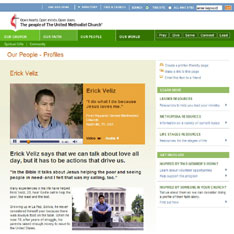
| ||||||||
| Church's New Web Site Fosters Online Community | |||||||||
|
NASHVILLE, Tenn. – UMC.org, the Web site of The United Methodist Church, has been retooled to incorporate innovative technologies to bring together people around the world in new ways. The pioneering site is home to the first large-scale social networking community developed by a mainline denomination for people of faith. The redesign was unveiled Jan. 29 during an online news conference with media and other audiences. "UMC.org is more than a Web site. It's about relationships," said the Rev. Larry Hollon, chief executive of United Methodist Communications. "... Now, information about spiritual enrichment is as easy as the click of a mouse." Designed to be user-friendly and relevant to daily life, the new design aims to meet the needs of a large, diverse audience and to make people feel welcome, as if walking into a church. "The new UMC.org is about community," Hollon said, noting that the site reflects denominational founder John Wesley's belief that the world was his parish. Hollon called UMC.org "a doorway" to The United Methodist Church and its ministries, accessing church resources, presenting the world "through the lens of faith" and offering visitors a closer look at who United Methodists are as a faith community. A technological tool Technology, he said "is a gift from God to transform lives, to attract young people, to reach out to children and to address significant issues of faith." Through it, visitors can hold online conversations about diseases of poverty, malaria and HIV/AIDS. They can "volunteer globally" through the Our World section, which presents how the denomination and individuals are responding to global issues and making a difference. Members can keep each other up to date on events and church news, stay connected with friends in other parts of the world, and keep in touch between worship and church gatherings. "The new UMC.org is a tool for the church to reach out to others and for the church to give to the world an opportunity, a doorway through which people may examine The United Methodist Church in more depth," Hollon said. "It is a pathway to the church, not a destination." More than two years in the making, the new UMC.org was designed and developed at a cost of $250,000 and includes the first-ever large-scale, faith-based community and social network developed by a mainline denomination. Matt Carlisle, director of web ministry at United Methodist Communications, calls the new online community a "centralized place" for people with wide-ranging beliefs to engage in online faith discussions at their convenience. "It is taking what the United Methodist Church has historically done so well and blending it with new technologies and connecting it grassroots, literally throughout the world," Carlisle said. Online community Similar to but offered as an alternative to MySpace and Facebook, the new social network is open to people of all faiths and accessible day or night. Visitors to http://www.umc.org/community/ can establish personal profiles with photographs and personal information, establish networks of friends and "blog" about a number of subjects. Unlike other social networking sites, however, members of this community can list their skills and gifts and share how they want to help make the world a better place. The idea is to connect those with needs with those who are equipped to help. Carlisle said UMC.org is committed to ensuring online safety and maintaining mutual respect within the new online community. A major concern with social networks is their openness that allows youth and young people to be targeted by predators. The UMC.org network, designed by Brick River Technologies of Exeter, N.H., includes filters that edit out offensive language, a requirement that participants are at least 13 years old, security technology review by senior professionals, manual review of photo and video content, and a self-monitoring approach that allows users to flag the content of inappropriate posts for review by an administrator. Hollon and Carlisle stressed that while online interaction is important, the site does not replace the face-to-face community that can be found within local congregations. "An online community will never, ever replace the church experience," Carlisle said. "You cannot wrap your hands around a computer monitor when you are at a point in time in your life when you've had a loss." Among the site's other features are: "Leader Resources," offering tools for effective leadership. "Our People," where visitors can identify their own personal spiritual gifts and find how they can use them to make a difference, and read inspirational stories of faith about members of The United Methodist Church. "Find-A-Church," allowing visitors to locate a United Methodist church in any community in the United States. "Pray," where visitors can submit a prayer request. "Serve," connecting people with volunteer opportunities in their communities. Site developer Hot Studio, based in San Francisco, considers the UMC.org redesign one of its most complex projects because of the diverse needs of a global denomination, Carlisle said. "Our goal with the new site has always been to build a Web site that reflects the church's concern for supportive community," Hollon said. "By basing the site on user input, and adding exciting new Web innovations, we feel we have developed the foundation for just such a site in UMC.org." |
| ||||||||
 |





